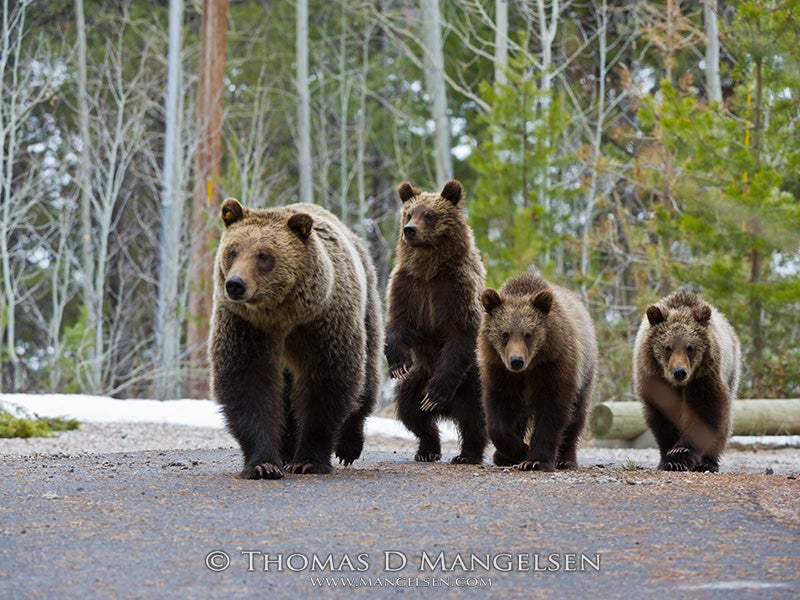
Grizzly 610 walks down a park road with her three cubs in springtime, April 13, 2012.
Photo courtesy of Thomas D. Mangelsen
September 24, 2018
Missoula, MT — Federal safeguards for Greater Yellowstone Ecosystem grizzly bears were reinstated today, after a judge ruled that the Trump administration’s decision to strip Endangered Species Act protections from the population was illegal.
The decision spares the grizzlies from a planned trophy hunt scheduled to begin this fall in Wyoming and Idaho. Earthjustice, representing the Northern Cheyenne Tribe, Sierra Club, Center for Biological Diversity and National Parks Conservation Association, argued for restoring protections to Yellowstone grizzly bears.
The decision spares the grizzlies from a planned trophy hunt scheduled to begin this fall in Wyoming and Idaho. Earthjustice, representing the Northern Cheyenne Tribe, Sierra Club, Center for Biological Diversity and National Parks Conservation Association, argued for restoring protections to Yellowstone grizzly bears.
“The Northern Cheyenne Nation views the grizzly bear as a relative entitled to our respect and protection from harm,” said Lawrence Killsback, President of the Northern Cheyenne Nation. “We have a responsibility to speak for the bears, who cannot speak for themselves. Today we celebrate this victory and will continue to advocate on behalf of the Yellowstone grizzly bears until the population is recovered, including within the Tribe’s ancestral homeland in Montana and other states.”
“We’re glad the court sided with science instead of states bent on reducing the Yellowstone grizzly population and subjecting these beloved bears to a trophy hunt,” said Bonnie Rice, Senior Representative for Sierra Club’s Our Wild America Campaign. “Changing food sources, isolation, inadequate state management plans and other threats that grizzly bears continue to face warrant strong protections until they reach full recovery.”
“People around the world will applaud the decision to again protect Yellowstone’s beloved grizzly bears under the Endangered Species Act,” said Andrea Santarsiere, a senior attorney with the Center for Biological Diversity. “Facing ongoing threats and occupying a fraction of their historic range, grizzly bears are nowhere near recovery. These beautiful and beleaguered animals certainly shouldn’t be shot for cheap thrills or a bearskin rug.”
“Grizzly bears that call Grand Teton and Yellowstone National Parks home will no longer be threatened by an aggressive hunt that was planned this fall on lands bordering the national parks, thanks to the court’s ruling,” said Bart Melton, Northern Rockies regional director for National Parks Conservation Association. “The Department of the Interior can now go back to the drawing board to hopefully consider what research, such as the long-term impacts of climate change on the population, must be considered to ensure a healthy long-term future for Greater Yellowstone Ecosystem grizzlies.”
Read the court decision.
Background
In August 2017, the U.S. Fish and Wildlife Service removed the Yellowstone-region grizzly bear population from the federal endangered and threatened species list, even though the area’s grizzly population has suffered high levels of human-caused deaths in recent years.This fall, for the first time in more than 40 years, the states of Wyoming and Idaho announced grizzly hunts that would have allowed for up to 23 bears to be killed outside of Yellowstone National Park. Today’s court ruling blocked the hunts. The court had previously issued an extended a temporary restraining order to prevent the hunt from proceeding while the judge finalized his decision.
The Northern Cheyenne Tribe and conservation groups challenged the Fish and Wildlife Service’s disregard of bear deaths following the bears’ recent shift to a more heavily meat-based diet following the loss of other foods.
The tribe and groups also faulted the Service for carving out and delisting the isolated Yellowstone grizzly population instead of focusing on a broader, more durable grizzly recovery in the West. They further challenged the Service’s decision to disallow public input on changes to its management framework for grizzlies, which weakened protections.
Learn more about the legal fight.